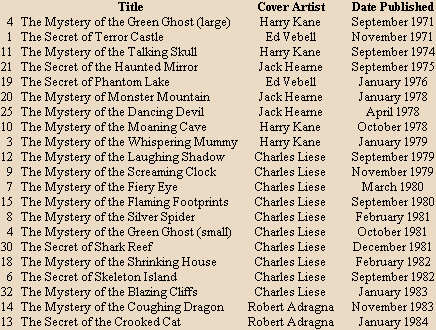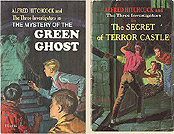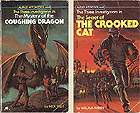|
Scholastic
In 1978, Random House changed The
Three Investigators retail/trade book format from hardcover to paperback.
Interestingly, that was not The Three Investigators first major entry into
the paperback market. In fact, even before the two Windward titles,
The Three Investigators began to be available in paperback through the
Scholastic Book Services (SBS) book club.
Like its "grown-up" book club counterparts,
Scholastic sold (and still sells) less expensive editions of thousands
of children's books. Usually paperback with lighter paper stock,
the books were only available through Scholastic catalogs and never sold in
retail book stores. These catalogs were typically distributed in
classrooms throughout the U.S. at least two times a year.
In 1971, Scholastic published its
first Three Investigators books: #4 The Mystery of the Green Ghost
in September and #1 The Secret of Terror Castle in November.
Both were slightly smaller than their Random House hardcover counterparts
(5 1/4" x 8 1/16", identical to the Windward size; essentially the same
size as the hardcoverís textblocks), but had the exact same cover art and
internal illustrations. In fact, the books used the same Random House
printing plates (same typeface), but with one exception:
both books had revised Hitchcock introductions to correct the chronological
problem of Green Ghost being published before Terror Castle.
Why Scholastic just didn't publish the books in their actual order may
never be known, but it makes for an interesting addition to Three Investigators
lore. A comparison of the text of the Random House and Scholastic
introductions can be found by clicking here: Terror
Castle | Green
Ghost.
The next Scholastic Three Investigators
paperback was #11 The Mystery of the Talking Skull, published in
September 1974. Like is two predecessors, Talking Skull also
sported the original cover art, but that is where the similarities ended.
With Talking Skull, Scholastic switched to a small-size format (approx.
4 1/8" x 7") and completely new typeface. There were no internal
illustrations and the cover art, was of course, scaled down to accommodate
the new size. The smaller size and different typeface would be Scholastic's
trademark for the remainder of its involvement in The Three Investigators,
giving Scholastic a distinction from the forthcoming Random House paperback
editions.
From September 1975 through January
1979, Scholastic published six more Three Investigators books, all in the
now standard paperback format:
#21 The Secret of the Haunted Mirror - September 1975
#19 The Secret of Phantom Lake - January 1976
#20 The Mystery of Monster Mountain - January 1978
#25 The Mystery of the Dancing Devil - April 1978
#10 The Mystery of the Moaning Cave - October 1978
#3 The Mystery of the Whispering Mummy - January 1979
Like #11 The Mystery of the Talking Skull, five of the six had their original cover art, with #10 The Mystery of the Moaning Cave the exception. The cover art was by the original artist, Harry Kane, but it was not quite the original
art. For this edition, Kane updated his original work with subtle style differences more appropriate for the 1970's. A side-by-side comparison
can be seen here. As can be seen, the appearance of the boys resembles how they looked in Kane's last work for Random House, 1971's #15 The Mystery of the Flaming Footprints and #16 The Mystery of the Nervous Lion. Why Scholastic updated Moaning Cave's cover art for their edition is still quite a mystery.
From September 1979 to January 1983,
Scholastic published ten more titles, but with a major difference: the
basic format was unchanged, but the original Random House cover art was
abandoned for brand new art by Charles Liese. This aspect is quite
intriguing, because by 1978 and 1979, Random House was publishing its own
paperback edition of The Three Investigators with new art by either Stephen
Marchesi or Robert Adragna. Why Scholastic chose to not use those
artists as well is somewhat of a mystery, but perhaps they were trying
to obtain as much distinction from the Random House editions as possible.
The ten published were:
#12 The Mystery of the Laughing Shadow - September 1979
#9 The Mystery of the Screaming Clock - November 1979
#7 The Mystery of the Fiery Eye - March 1980
#15 The Mystery of the Flaming Footprints - September 1980
#8 The Mystery of the Silver Spider - February 1981
#4 The Mystery of the Green Ghost (small) - October 1981
#30 The Mystery of Shark Reef - December 1981
#18 The Mystery of the Shrinking House - February 1982
#6 The Secret of Skeleton Island - September 1982
#32 The Mystery of the Blazing Cliffs - January 1983
As can be seen, Green Ghost
was published again in 1981, but in the new smaller format. This
Second Scholastic Paperback Edition also used the revised introduction,
but with the newer typeface. To my knowledge, the large
size #1 The Secret of Terror Castle was never republished in the
smaller format.
In November 1983 and January 1984,
Scholastic published its last two Three Investigators books, #14 The
Mystery of the Coughing Dragon and #13 The Secret of the Crooked
Cat. As expected, the small format was used, but
both now featured their corresponding Random House paperback cover art
by Robert Adragna. The artwork was scaled down, but different typeface was used for the title. In addition, the company's name
had changed, from Scholastic Book Services to simply, Scholastic, Inc.
Printing Identification
Unlike Random House, Scholastic always
made printing identification very simple. Any book published prior
to 1976 had the printing stated on the copyright page as 1st Printing,
2nd Printing, etc. For those published or printed from 1976 on, the
printing is identified by a numberline: a First Printing will have a 12
11 10 9 8 7 6 5 4 3 2 1 numberline and a Second Printing will have a 12
11 10 9 8 7 6 5 4 3 2, etc.
Printing Date Identification
Again, prior to 1976, determining
the year and month Scholastic printed a title is very easy: it was clearly
stated on the copyright page. From 1976 on, however, Scholastic began
to encode the printing date information as additional number sequences
that resided to the right of the printing numberline. A basic method to "decode" these number sequences was developed a few years ago by fellow collectors Kenneth Hopping and Seth Smolinske. An expanded version (that covers all printing dates, not just the First Printing) follows:
Please refer to the sample copyright
pages below. Example 1 is a First Printing as identified by the left
side numberline that ends in a "1." The middle number indicates the
printing month: October. This middle number is only present on First
Printings to identify a more complete publishing date. The right
side numberline reveals the printing year to be 1981 from the following
formula: year = 19XY, with Yn...n/X. By comparing multiple printings
of all the Scholastic titles, I discovered that this sequence is dynamic,
with digits dropping when a new printing occurs in a different year.
That means that books printed over two decades (1970s/1980s or 1980s/1990s) will have two successive sets
of Xs and Ys. Example 2 shows this. It is a First Printing
from January 1979. A Second Printing of it would lack the 9/7, giving
a 0 1 2 3 4/8 numberline, or 1980.
The two additional digits on the
lower right are always either 01 or 06. The exact nature of these digits is still unknown, but perhaps they indicate the school semester
in which the book was sold.
Notes
For books published after 1971, other
available titles were listed on an inner list located on the copyright
page. This list was updated with each printing to reflect the additional
titles available, much like the Random House Trade Hardcover back cover
list.
Scholastic never referenced each
book's number in any location (spine, covers, inner list, etc.).
Surprisingly, many of the nineteen small-size titles were still in print in 1988, one year past Random House's end of the original series.
Complete List
A complete list of the twenty Three
Investigators titles published by Scholastic, in the order they were published,
is as follows:

Collector's Notes
Most of the Scholastic books are plentiful in the used book market, but a few are somewhat harder to find and it can take a little time to acquire an entire
set. In general, all of the Scholastic books are very inexpensive; for the average collector, they simply don't appear to be in demand.





Home << Previous | Next >> << Previous | Next >>
This page last updated on 02-Sep-03
|